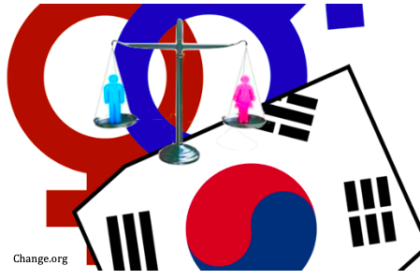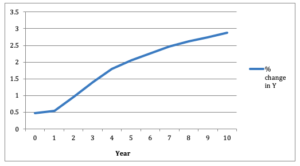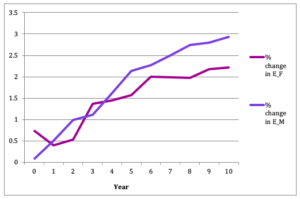
In terms of “Economic Participation and Opportunity” South Korea is one of the lowest-ranked countries in the world (124th out of 149 countries) as of 2018. Global Gender Gap Index also shows that South Korea ranks 88th in terms of female labour force participation and 121st in terms of gender wage equality for similar work. The average wages of women in South Korea are on average 36.7% lower than average male wages (as of 2012, Oyvat and Onaran, 2020). Hence, there is a significant economic gender gap in South Korea despite the fact that the country is now classified as a high-income economy. Moreover, the underdeveloped care infrastructure and reliance on unpaid care labour of women is posing serious demographic and social sustainability challenges in an aging society.
Our new research analyses the effects of public social expenditure in education, health and social care and closing gender pay gap on aggregate output and female and male employment (Oyvat and Onaran, 2020). We introduce a structuralist gendered model of the demand and supply sides of the economy with endogenous productivity, labour supply and wage bargaining. Empirically, we use a structural vector autoregression (SVAR) analysis to econometrically estimate the effects of an increase in social infrastructure spending, female and male wages, and closing the gender pay gap on aggregate output and employment of men and women in South Korea for the period of 1970-2012.
Public social expenditure, specifically education played an important role in the rise of South Korean economy. The social sector has not only been a sector that is crucial for economic growth in South Korea, but it has also been important for generating female employment and closing gender employment gaps. The share of women in employment in the social sector (education, healthcare and social care) has been greater than in the rest of the economy since the 1970s. The share of female employment in the social sector in South Korea increased from 47.4% during the period of 1988-1997 to 58.3% in 1998-2007 and to 63.2% in 2008-2012. In contrast, the share of female employment in the rest of the non-agricultural economy is only 27.7% in 1998-2007 and 28.4% in 2008-2012. The female employment share even in sectors which traditionally had a high female employment such as food, beverages, tobacco, textiles, leather, and footwear or electrical and optical equipment have been steadily declining and is lower than the female employment share in the social sector in the post-1998 period.
Our theoretical framework identifies the possible channels through which public social spending influences total output, male and female employment. In the short-run, the increase in public social spending has a positive effect on total output and female and male employment. While higher social public expenditure may increase public debt/GDP in the short-run, this negative effect is moderated as tax revenues also increase alongside aggregate income, which in turn offsets any potential crowding out effect on private investment. As the female employment share is significantly larger in the social sector than in the rest of the economy, higher public social expenditure is expected to reduce the gender employment gap.
In the medium-run, higher public social expenditure is expected to have not only a direct positive effect on labour productivity, but also an indirect positive effect through i) higher output and benefits of increasing returns to scale; ii) higher wages creating incentives for adopting labour-saving technologies; and iii) higher private expenditure in education, health and social care by the households as income, in particular female income increases. Due to these effects on productivity, we refer to public social expenditure as social infrastructure investment.
Figure 1: The cumulative impact of a 1% increase in social expenditure (YH) on aggregate non-agricultural output (Y)

The estimation results show that a 1% increase in the public social expenditure in South Korea increases non-agricultural output by 0.5% contemporaneously, and by 2.3% in cumulative over six years and 2.9% over ten years (Figure 1). As a result female and male employment increase contemporaneously by 0.7% and 0.1% respectively (Figure 2). The short-run impact is larger for female employment as the share of women is significantly higher in the social sector compared to the rest of the non-agricultural sector. In ten years female and male employment increase by 2.2% and 2.9% respectively. Finally, labour productivity increases by 0.22% over four years.
Figure 2: The cumulative impact of a 1% increase in social expenditure (YH)on female (EF) and male employment (EM)

The results also show that an increase in female wage rate has a significant positive effect on output. A 1% increase in female wages leads to a cumulative increase in output by 0.2% in year 3 and by 0.3% over 10 years. This shows that the South Korean economy is female wage-led/gender equality-led in the medium-run; hence higher equality is conducive to growth and development. The cumulative impact of a 1% increase in the male wage rate on output is 0.2% over 10 years. It is also important to emphasize that higher male wages are not an impediment to growth in South Korea. The results also indicate the importance of improving gender equality as part of an equality-led development policy.
Our research shows that an equitable development path in which both average wages increase and gender gaps close via an upward convergence in the wages of men and women is possible in South Korea. However, the effects from wages are economically small in comparison to the strong effects of social spending. The results indicate that sustainable equitable development and a substantial increase in employment requires a mix of both labour market and fiscal policies.
This blog is authored by Cem Oyvat and Özlem Onaran are both expert researchers for the Care Work and the Economy Project within the Rethinking Macroeconomics working group. To learn more read the CWE-GAM working paper upon which this blog was based here.
